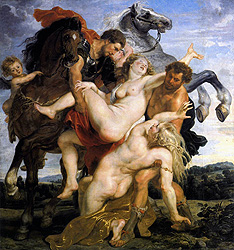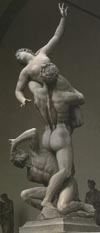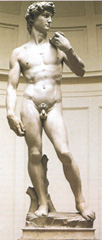
An alternative, feminist reading of several of the works discussed in "Authoritative and Disciplined Discussions of Master's Pieces," is presented by Margaret Carroll in an article entitled "The Erotics of Absolutism: Rubens and the Mystification of Sexual Violence" (in The Expanding Discourse: Feminism and Art History, eds. Norma Broude and Mary D. Garrard, pp.138-159). For the complete article see JSTOR.:

p. 139: Rubens's Rape of the Daughters of Leucippus confronts its viewers with an interpretative dilemna. Painted about 1615 to 1618, the life-size composition illustrates the story recounted by Theocritus and Ovid of how the twin brothers Castor and Pollux (called the Dioscuri) forcibly abducted and later married the daughters of King Leucippus. Rubens's depiction of the abduction is marked by some striking ambiguities: an equivocation between violence and solicitude in the demeanor of the brothers, and an equivocation between resistance and gratification in the response of the sisters. The spirited ebullience and sensual appeal of the group work to override our darker reflections about the coercive nature of the abduction. For these reasons many viewers have wanted to discount the predatory violence of the brothers' act and to interpret the painting in a benign spirit, perhaps as a Neoplatonic allegory of the progress of the soul toward heaven, or as an allegory of marriage. Although I agree that a reference to marriage may be at play here, I also believe that any interpretation of the painting is inadequate that does not attempt to come to terms with it as a celebratory depiction of sexual violence and the forcible subjugation of women by men....
The pleasures of sexual violence had long been championed in Ovid's Art of Loving, where indeed / p. 140 this particular rape-- by the Dioscuri of the sisters Pheobe and Hilaira-- was cited as an example of how a lover might conquer the object of his desire by using force:
| Though she give them not, yet take the kisses she does not give. Perhaps she will struggle at first and cry, "You villain!" Yet she will wish to be beaten in the struggle....He who has taken kisses, if he take not the rest beside, will deserve to lose even what was granted.... You may use force; women like you to use it....She whom a sudden assault has taken by storm is pleased....But she who, when she might have been compelled, departs untouched...will yet be sad. Phoebe suffered violence, violence was used against her sister: each ravisher found favour with the one he ravished. |
In applying this passage from Ovid to Rubens's painting, one art historian draws the conclusion that Rubens is celebrating the triumph of natural impulse over conventional inhibition: "The battle of the sexes is a necessity of nature. With Rubens it is a primal impulse of life, a fight for unification.....In being raped Pheobe discovers her destiny as a woman. Her rape reveals and enhances her nature." In claiming something like a truth value for Rubens's celebratory depiction of this rape, this scholar mystifies it in terms of a misguided notion of what is natural in human sexuality. My point is that we must consider Rubens's painting not as a revelation of primal human nature but as a phenomenon of sixteenth- and seventeenth- century European culture. In particular we may view Rubens's painting as issuing from a tradition that emerged among princely patrons at the time, of incorporating large-scale mythological rape scenes into their palace decorations. With fundamental shifts in political thinking and experience in early sixteenth-century Europe, princes came to appreciate the particular luster rape scenes could give to their own claims to absolute sovereignty....
/p. 141 Of particular interest here are instances in which
evocations of princely power and dominance are given a distinctly sexual coloration.
The best known of course is in chapter 25 of The Prince (1513), where
Machiavelli urges the Prince to use force in contending with adverse circumstances:
Fortune is a woman and if you wish to keep her under it is necessary to beat
and ill use her; and it is seen she allows herself to be mastered by the adventurous
rather than by those who go to work more coldly. She is, therefore, always woman-like,
a lover of young men, because they are less cautious, more violent, and with
more audacity to command her....
| The German Expressionist painter Kandinsky wrote in 1913 of his experience of beginning a new canvas: Thus I learned to battle the canvas, to come to know it as a being resisting my wish (dream), and to bend it forcibly to this wish. As first it stands there like a pure chaste virgin... And then comes the willful brush which first here, then there, gradually conquers it with all the energy peculiar to it, like a European colonist. |
/p. 142 In this absolutist conception of political rule the relationship between a prince and the state is less in the figure of the prince as the head of the single (male) body of the republic than in the figure of two bodies: the prince taking forcible possession of a (usually) female body, the latter having no power to resist or make claims upon him.
Once this refiguration of the prince's relation to his subjects is understood, it becomes readily apparent why, in 1583..., Francesco de' Medici, would have found it appropriate to install Giovanni da Bologna's so-called Rape of a Sabine in the Loggia dei Lanzi on Florence's Piazza della Signoria.

Apparently Giovanni da Bologna composed the group without any particular story in mind. But that is not to say that the action here is ambiguous. The sculpture's subject is only ambiguous if one tries to link it to a particular historical narrative. As a generic rape scene, its meaning is perspicuous that of a victory monument to Medicean success in subjugating the citizens and subject territories of Florence....

In contrast to earlier allegories of the city [e.g. Michelangelo's David], here the personified Florence is not an active subject but a passive object; not the victor but the victor's possession, the trophy in a contest between men. Indeed a contemporary poem aboput the sculpture likens Florence to the Sabine woman and praises Francesco, "who with such valor, with such wisdom possesses her."
/p. 143 ...[T]he main view of the the group from the front does yield a more or less coherent view of the bodies of both men. It is the woman's body that we see only as a fractional part, which lacks integrity and has become fetishlike. The fetishistic display of the Sabine woman's body effectively complements the display of the head of Medusa in Cellini's Perseus --the sculpture with which Giovanni de Bologna's group was paired in the Loggia dei Lanzi.
In each work the virile hero holds aloft part of a woman's body as evidence of his capacity to dispossess and incapacitate his enemies. Each work plays upon the thematics of sexual prowess and disempowerment as a way of establishing the hero/ruler's virtu in facing down opposition.
The concept of virtù surmounting difficulty through the use of force is of course central to Machiavelli's delineation of the ideal prince and is a recurrent theme in subsequent Florentine political rhetoric. The gendered signification of the word virtù in particular (meaning, literally, manliness) surely underlies the sexual innuendo in Machiavelli's endorsement of princely violence, quoted above. The convergence of the sexual and political meanings in the concepts of force and virtù help clarify why this rape group could be taken as a fitting embodiment of those values and serve as a daunting public affirmation of Medicean princely prowess.
A curious point to note is the way in which these same terms - virtù, forza, difficultà -- were applied not only to sexual and political experience in sixteenth-century Florence but to artistic experience and theory as well. Poems and texts written after the sculpture was unveiled in 1583 take up precisely those terms lauding the sculptor's accomplishment. Raffaello Borghini asserts that Giambologna made the group to prove to jealous rivals that he could produce large figures in marble. "Goaded by the spur of virtù, he arranged to show the world that he could not only make ordinary marble statues, but also many together, and the most difficult that could be made." It has long been recognized how central these terms are to Renaissance and particularly mannerist artistic theory. However, by translating virtù as "virtuousity," for example, art historians have neglected to consider how sixteenth-century writers used the /p. 144: terms to claim for artistic achievement the glory of sexual and political conquest.
Excerpts from
Yael Even
The Loggia dei Lanzi: A Showcase of Female Subjugation
reprinted in The Expanding Discourse: Feminism and Art History, eds. Norma Broude and Mary D. Garrard, pp.126-137:
As a politically oriented sculpture gallery,
the Loggia dei Lanzi on the  Piazza
della Signoria in Florence (1376-82) is an artistic arena for patriarchal propaganda.
The piazza's most publicly acclaimed artworks - -Benvenuto Cellini's bronze
Perseus and Medusa (1545-54) and Giovanni da Bologna's marble Rape
of a Sabine (1581-83)-- were conceive both as overt and covert symbols of
ruling powers. Depicting popular heroic exploits from classical antiquity, the
two statues explicitly glorify the Medici reigns of Cosimo I and Francesco I,
who, respectively, commissioned them. At the same time, presenting these mythical
feats of bravery as sexualized conquest wherein male protagonists subdue female
adversaries, they proclaim as well, perhaps subconsciously, men's longed-for
control over women.
Piazza
della Signoria in Florence (1376-82) is an artistic arena for patriarchal propaganda.
The piazza's most publicly acclaimed artworks - -Benvenuto Cellini's bronze
Perseus and Medusa (1545-54) and Giovanni da Bologna's marble Rape
of a Sabine (1581-83)-- were conceive both as overt and covert symbols of
ruling powers. Depicting popular heroic exploits from classical antiquity, the
two statues explicitly glorify the Medici reigns of Cosimo I and Francesco I,
who, respectively, commissioned them. At the same time, presenting these mythical
feats of bravery as sexualized conquest wherein male protagonists subdue female
adversaries, they proclaim as well, perhaps subconsciously, men's longed-for
control over women.
The Loggia dei Lanzi, originally a ceremonial galley for government officials, was built on the south side of the Piazza della Signoria at right angles with the Palazzo Vecchio. In the sixteenth century, it was adorned with statues, and it gradually became more of what Carol Duncan in another context has described as a "ritual setting" for "male transcendence" and a "powerful engine of ideology." Donatello's bronze Judith and Holofernes (1456-57), the first image of rule to be placed under the west arch, in celebration in 1506 of the Florentine citizenry and the only one to display the courageous deed of a biblical female hero, was destined to be eclipsed by other, more patriarchally sanctioned images. In 1554, its dominant presence was counteracted by Cellini's Perseus and Medusa, which was placed beside it under the east arch. Less than thirty years later, it was replaced altogether by Rape of a Sabine by Giovanni da Bologna (also known as Giambologna) and was removed, partly away from the public eye, to the south arch, the only location in the gallery that does not face of the Piazza della Signoria....
Donatello, Judith and Holofernes, 1456-57.
/p. 129: The relentless attempt all but to dispose of the Judith and Holofernes was a blatant manifestation of misogynous attitudes, yet this verifiable fact has not been fully examined. The repeated displacement of Donatello's highly regarded sculpture was so uncommon a course of action that it was noted as excessive in contemporary accounts. Resentment or unease about the statue's female protagonist surfaced at the time that the sculpture was granted public status. Despite its origins as a private commission by Piero de' Medici about 1456, the Judith and Holofernes evolved into a civic monument as soon as it had been completed. Records reveal that one of its inscriptions was a dedication by its patron to the invincibility of the Florentine republic. Thus the statue came to function as a symbol of republican virture. In 1495, following the expulsion of the Medici from Florence, it became the property of the government as well as a landmark of the commune. Transferred from the garden of the Palazzo Medici to the ceremonial parapet next to the entrance of the Palazzo Vecchio, the Judith and Holofernes heralded the transformation of the Piazza della Signoria into the political center of the city.
Public awareness of the significance of the sculpture's location there arose in 1504 during the debates concerning the placement of the newly completed David by Michelangelo (1501-4). At this time the monumental marble statue of David was recognized as the supreme symbol of republican virtue, which resulted, in part, in a devaluation of Donatello's much smaller bronze statue as a personification of the state. Moreover, the decision to move the David from the cathedral to the square entailed a reassessment of the central vantage point that the/p. 130: Judith had occupied since 1495. Of the arguments voiced in this regard, the most revealing and influential was that of Francesco di Lorenzo Filarete, the representative of the Signoria, the Florentine governing body. Like other members of the appointed committee, he recommended the substitution of the David for the Judith. More important, he discredited Donatello's image, which he described as a metaphor of death, and deplored its unsuitability, because it presented a female hero slaying a male adversary. Filarete stated, "It is not fitting for the Republic --especially when our emblems are the cross and the lily-- and I say that it is not fitting that the woman should kill the man." The sculpture was removed to the courtyard of the Palazzo Vecchio (1504) and then to the Loggia dei Lanzi (1506), where, however, it was not fated to remain for long.
Benvenuto Cellini was the first to restore patriarchal order in this public gallery when he planned his Perseus and Medusa more in direct competition with Donatello's Judith and Holofernes than as a pendant to it. Symbolizing what Margaret Carroll has described as Cosimo I's "absolutist conception of political rule," the Perseus and Medusa was designed to downplay the symbolism of the Judith and Holofernes, which had come to represent the struggles against tyranny of the now-defunct Florentine republic. Indeed, commissioned in 1545, the Perseus and Medusa was to celebrate the grand duke's success, two years earlier, in convincing Charles V to withdraw his Spanish troops from the Fortezza in Florence and the port of Piombino.... Officially, Cellini's statue was to commemorate Cosimo I's move from the Palazzo Medici to the Palazzo Vecchio in 1540, and it became one of the numerous metaphors of his power in the Piazza della Signoria. Unofficially, however, it must have been calculated to undermine the impact of what had been said to be the distasteful beheading in public of a male adversary by a female protagonist.
/p. 131: The subject of Cellini's bronze group was perfectly suited for this task. As Marina Warner had observed, in ancient Greek culture Medusa's downfall at the hands of Perseus... represented the defeat of matriarchy.